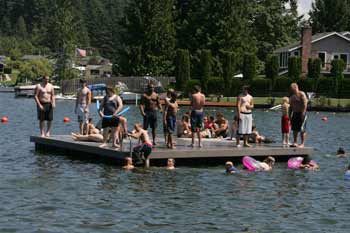The floating dock’s days are numbered.
The Allan Yorke Park swimming area fixture may have seen its last summer as the city is preparing to pull it out of the water as part of a series of new safety measures proposed by Mayor Neil Johnson in response to the June 21 drowning death of teenager Quentin Boggan.
The mayor is also proposing a series of new signs, including a pair of digital water temperature signs to make sure swimmers know what they are getting into.
In addition, a 911 call box will be installed at the park.
Johnson detailed his proposals, including the cost of some measures, during Tuesday’s council workshop.
“Hopefully it will just be some added safety measures for the park and hopefully we won’t have a tragedy like we did a few weeks ago,” Johnson said.
The council’s Public Safety Committee also agreed to look at the possibility of bringing lifeguards to the park, though due to costs and training, it will not be possible to have guards this year should the council decide they are necessary.
But the floating dock’s removal will be the most noticeable change.
“This one I’m kind of torn about,” Johnson told the council, adding that he worried about being a “prude” but thought the safety component was more important. He also said while the dock will be removed for the remainder of this summer, the move would be re-evaluated in the off season after the public had a chance to weigh in.
“I think it might be the right thing to do,” he said. “And we can always put it back next year.”
Johnson said his decision to recommend the dock’s removal came because he worried it was an attraction for kids outside the general swimming area and that it is often quite crowded, leading to possibly unsafe conditions and unnecessary danger.
“It’s a tough call, but I want to error on the side of additional safety until we can get a feel for what our community thinks of the floating dock,” Johnson said in an email. “Who know’s how many kids who are not strong swimmers (who try) to swim to the dock?”
The floating dock was not installed in each of the past two summers.
“It’s just not a safe place to be,” said Council member Katrina Minton-Davis, who said she often sees kids standing shoulder-to-shoulder and pushing and shoving while on the dock.
The cost of removing the dock is approximately $300 and public works crews plan to take it out of the water as soon as possible.
While many of the proposed measures are minor, including new stenciling and signs warning that the lake’s swimming area is unguarded and new personal floatation devices added to the life jacket kiosk, the temperature signs will cost the city approximately $5,000 each.
According to Johnson and Facilities and Special Projects Manager Gary Leaf, the temperature signs will be the first of their kind. The signs will use probes in the lake to transmit the information wirelessly to the digital signs. One of the signs will be posted near the boat launch and the second in the swimming area, though a definitive location has not been decided.
The temperature signs are particularly useful at Lake Tapps because the lake is constantly replenished by water from the White River, which is fed through glacial melt. The water under the surface of the lake is usually much colder than the top layer, which is slightly heated by the sun.
Because of the nature of the lake water, Lake Tapps swimmers are at a higher risk of hypothermia than those in a pool or other, warmer lakes.
The 911 call box will cost the city $400 annually and serve as a direct line from the park to police dispatch. Johnson said the box would not only help in lake emergencies, but would also give park goers an immediate link to the police if they were in danger.
The Public Safety Committee has also committed to re-assessing the issue of lifeguards at the park. Johnson said staff has been researching the matter, including contacting other cities with lakefront parks, and figure the city will need two or three lifeguards working between 30 and 40 hours a week at a cost somewhere between $60,000 and $90,000.
In addition to the safety improvements, Johnson said a memorial sign for Boggan is planned for the park, but will not be installed until “the family is ready.”



